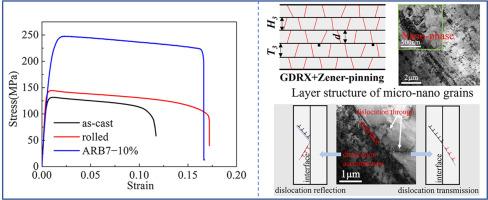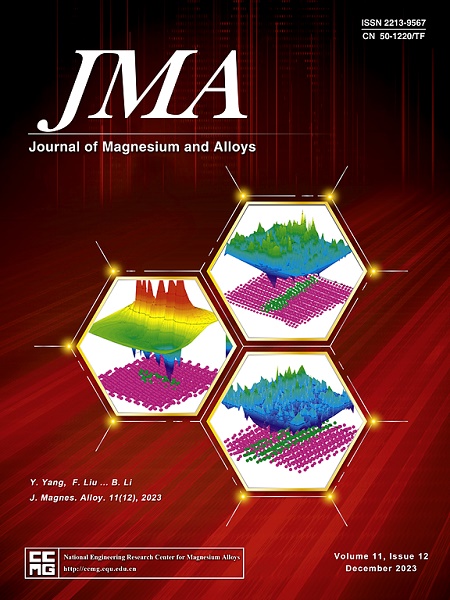Balancing strength and ductility of LA141 alloy with a micro-nano laminated structure
IF 15.8
1区 材料科学
Q1 METALLURGY & METALLURGICAL ENGINEERING
引用次数: 0
Abstract
The laminated LA141 sheets were processed by the accumulative roll bonding (ARB). The interaction between dislocations and laminated interfaces, and the effect of bond interface spacing on the dynamic recrystallisation (DRX) behavior and mechanical properties were investigated. The results show that, with the increase of ARB cycles, physical metallurgical bonding is enhanced. MgLi2Al nanophases and fragmented MgO particles are formed at the bond interface during ARB process, which has a significant positive effect on the interface bonding. With the increase of ARB cycles, the bond interface spacing decreases, DRX mode changes from continuous dynamic recrystallization (CDRX) to geometrical dynamic recrystallization (GDRX), and the Zener-pinning effect is enhanced, which facilitates the grain refinement strengthening. The bond interface can not only effectively hinder the movement of dislocations causing strengthening, but also absorb, reflect and transmission the dislocations causing the improvement of the ductility. The final LA141 alloy possesses a tensile strength of 247 MPa and an elongation of 16.6 %, of which is 93.0 % and 70.3 % higher than the as-cast alloy, respectively.

利用微纳米层状结构平衡 LA141 合金的强度和延展性
层压 LA141 板材是通过累积辊粘合 (ARB) 工艺加工而成的。研究了位错与层压界面之间的相互作用,以及结合界面间距对动态再结晶(DRX)行为和机械性能的影响。结果表明,随着 ARB 周期的增加,物理冶金结合得到了增强。在 ARB 过程中,结合界面上形成了 MgLi2Al 纳米相和破碎的氧化镁颗粒,这对界面结合有显著的积极影响。随着 ARB 周期的增加,结合界面间距减小,DRX 模式从连续动态再结晶(CDRX)转变为几何动态再结晶(GDRX),齐纳引线效应增强,有利于晶粒细化强化。结合界面不仅能有效阻碍位错的运动,导致强化,还能吸收、反射和传输位错,从而提高延展性。最终的 LA141 合金的抗拉强度为 247 兆帕,伸长率为 16.6%,分别比铸造时的合金高出 93.0% 和 70.3%。
本文章由计算机程序翻译,如有差异,请以英文原文为准。
求助全文
约1分钟内获得全文
求助全文
来源期刊

Journal of Magnesium and Alloys
Engineering-Mechanics of Materials
CiteScore
20.20
自引率
14.80%
发文量
52
审稿时长
59 days
期刊介绍:
The Journal of Magnesium and Alloys serves as a global platform for both theoretical and experimental studies in magnesium science and engineering. It welcomes submissions investigating various scientific and engineering factors impacting the metallurgy, processing, microstructure, properties, and applications of magnesium and alloys. The journal covers all aspects of magnesium and alloy research, including raw materials, alloy casting, extrusion and deformation, corrosion and surface treatment, joining and machining, simulation and modeling, microstructure evolution and mechanical properties, new alloy development, magnesium-based composites, bio-materials and energy materials, applications, and recycling.
 求助内容:
求助内容: 应助结果提醒方式:
应助结果提醒方式:


